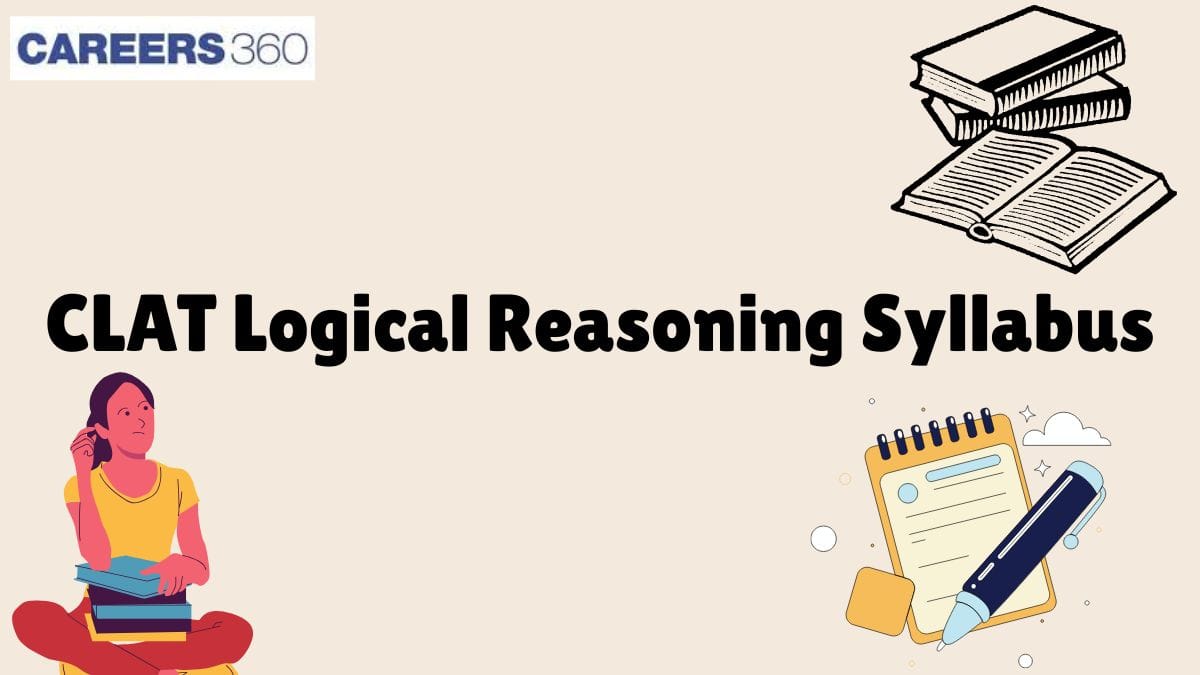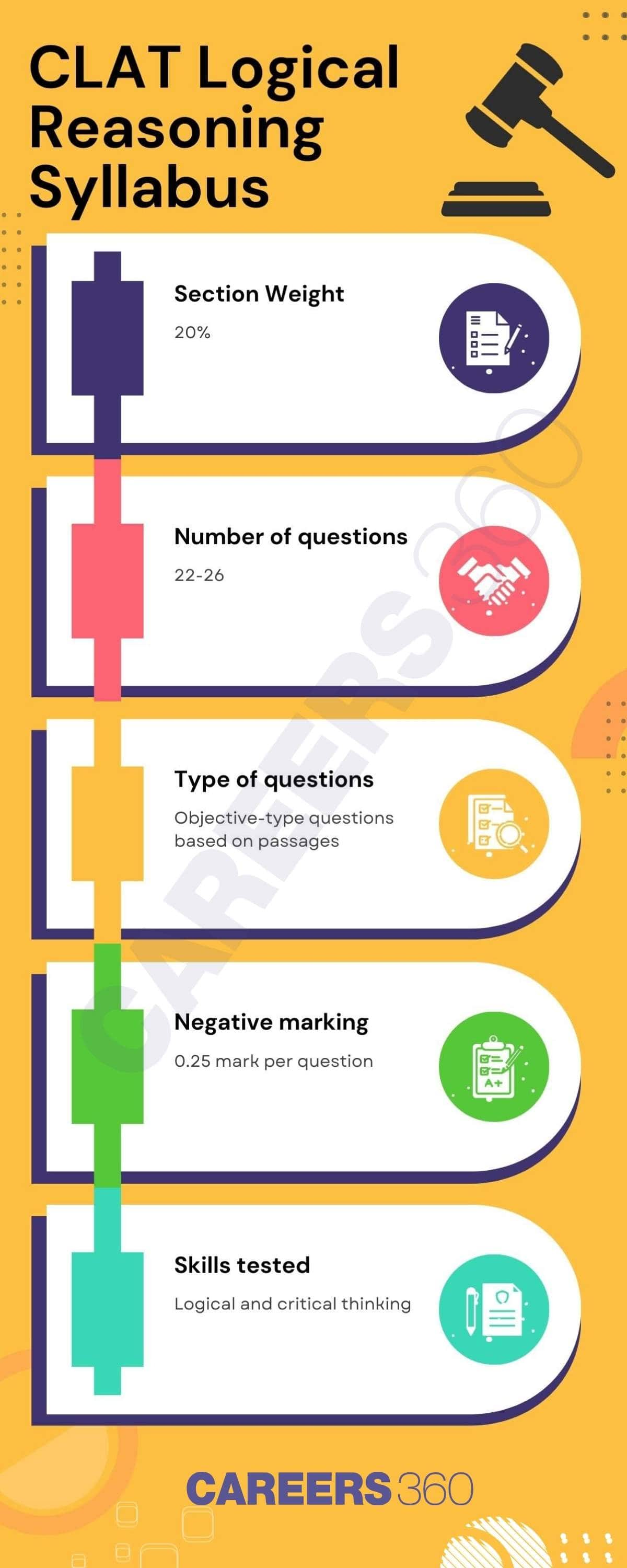UPES Integrated LLB Admissions 2026
Ranked #18 amongst Institutions in India by NIRF | Ranked #1 in India for Academic Reputation by QS Rankings | 16 LPA Highest CTC
The Consortium of NLUs (CNLUs) prescribes the CLAT logical reasoning syllabus 2026 on its official website consortiumofnlus.ac.in. The CLAT 2026 logical reasoning syllabus tests the candidate’s logical and critical thinking skills, essential for anyone in the legal profession. The logical reasoning section will comprise short passages of approximately 450 words, followed by one or more questions that evaluate critical thinking and argument analysis. The CLAT logical reasoning section will have a 20% weightage in the CLAT syllabus 2026. Questions in the syllabus of CLAT logical reasoning 2026 will be based on underlying passages. However, this section focuses on analytical reasoning and critical evaluation, essential for problem-solving in legal studies.
The steps to download the CLAT 2026 result are provided below.
This Story also Contains

The CLAT 2026 is scheduled to be conducted on December 7, 2025, in offline mode. There will be 22-26 multiple-choice questions based on underlying passages from the CLAT logical reasoning syllabus 2026 in the exam. Through the Common Law Admission Test, candidates will be admitted into 5-year LLB programmes of CLAT colleges participating in the exam.
| Particulars | Details |
|---|---|
Section Weightage | 20% |
Number of questions | 22-26 |
Type of questions | Objective-type questions based on passages |
Skills tested | Logical and critical thinking |

Like other sections in the exam, the logical reasoning syllabus for CLAT 2026 will have multiple-choice questions based on underlying passages. There will be 2-4 passages of 450 words each. Candidates are required to apply critical thinking to solve questions based on the passage.
The topics in the CLAT syllabus for Logical Reasoning are explained in detail below:
Drawing Analogies: Making comparisons between two fact scenarios or arguments and identifying their similarities and differences.
Conclusions and Inferences: Drawing logical inferences and conclusions from given statements
Premises and Assumptions: Identifying the assumptions and premises in given statements and predicting the likely result.
Cause and Effect: Identifying the likely factors that have led to a certain outcome or result and studying the cause and effect relationships between the situations.
The syllabus of CLAT 2026 logical reasoning will evaluate the following skills in the candidates:
Identify arguments, their underlying assumptions, and logical conclusions
Identify patterns of reasoning present in different arguments
Study the underlying premises in arguments and see how the argument can be strengthened or weakened by altering the premise or assumptions
Draw conclusions from given arguments or situations and apply them to new situations
Compare and contrast different arguments
Candidates can follow the tips given below to prepare for the syllabus of CLAT logical reasoning-
Candidates must work on strengthening their analytical skills by repeatedly engaging in solving problems and puzzles that require critical thinking.
One can make use of diagrams and charts to visualise problems and the likely solutions thereof.
The questions must be answered based on the information given, and candidates must not make any unnecessary assumptions outside of the given arguments.
Practising with previous year's CLAT question papers can help candidates know the type of questions to expect in the exam and prepare well.
Candidates must work on utilising the given time effectively. Solving problems and puzzles can be time-consuming, so candidates must plan and allocate time as per their level of preparation to score maximum marks in the exam.
Reading and comprehending the information accurately is very important in order to solve the problem correctly. Candidates must work on improving their reading and comprehension skills by engaging in regular reading habits through which they can grasp the assumptions and premises in the given statements fairly quickly.
Finally, candidates must refer to good books on CLAT logical reasoning to build a sound conceptual understanding to solve the problems.
Given below is a list of books for the CLAT logical reasoning 2026 syllabus. The list is not exhaustive, and candidates must consider various factors such as the author, publication, syllabus followed, and availability of practice question papers before finalising the books.
Sl. No | Books |
|---|---|
1 | How to Crack Test Of Reasoning by Arihant Experts |
2 | Analytical Reasoning by MK Pandey |
3 | A New Approach to Reasoning Verbal & Non-Verbal – B.S. Sijwali & Indu Sijwali |
4 | A Modern Approach to Logical Reasoning by R S Aggarwal |
You may also check other subjects' syllabus:
Frequently Asked Questions (FAQs)
The logical reasoning syllabus for CLAT 2026 will consist of passages followed by questions that require the candidates to apply logical thinking to identify premises and draw logical conclusions from given statements.
Candidates can prepare for CLAT logical reasoning by repeatedly practising with problems and puzzles to develop their logical and analytical thinking. Additionally, candidates must practise with mock tests and previous year question papers.
The five subjects in CLAT 2026 are English, current affairs including GK, legal reasoning, logical reasoning, and quantitative techniques.
On Question asked by student community
Hello,
With a score of 82 in CLAT 2026 under the EWS category, you do have a chance at getting into decent NLUs, but it may depend on the specific NLU and the cut-offs for this year.
Generally:
Top NLUs (like NLSIU, NALSAR, NUJS, WBNUJS) usually have higher cut-offs, so 82 might be below their usual EWS opening rank.
Mid-tier NLUs (like HNLU, GNLU, RMLNLU, NLUJ) could be within reach.
Lower-ranked NLUs and state NLUs are more likely to accept your score.
Your best step is to check the previous years’ EWS cut-offs for each NLU to see where your rank might fit.
Hope it helps !
Hello,
NUJS is among the top tier law colleges in the country. A high score in CLAT is required to get into NUJS. For you, getting into NUJS is possible but challenging. The cut off for general category often is very high (+90), but you WB domicile improves your chances for admission. Keep an eye on the final rank list and cut off.
Thank you.
Hello
With a score of 91.5 in CLAT UG 2026, your expected All India Rank would likely fall somewhere around AIR 500 to 1,000, based on previous years’ trends. The exact rank can shift depending on how tough the paper was and how other students performed. Since you belong to the OBC category, your category rank will be even better. This score definitely keeps you in a competitive range for several NLUs.
Hello,
CLAT or Common Law Admission Test is conducted for admission to top tier law colleges in India. The exam is conducted by Consortium of National Law Universities. While NLU's are generally not available for admission at this rank but there are many private colleges which offer good legal education and placements. JINDAL, UPES, Amity Law School, Lovely Professional University, IFIM Law School, Alliance University and many more. For more information you can check out the official website of Careers360.
https://law.careers360.com/articles/top-colleges-other-nlus-accepting-clat-scores
Thank you.
If you are expecting around 80 marks in CLAT 2026, your chances will mainly depend on that year’s overall difficulty level and how the marks translate into ranks. In most years, a score around 80 usually places candidates somewhere in the mid-rank range, which means that the top NLUs like NLSIU Bengaluru, NALSAR Hyderabad or WBNUJS Kolkata are generally difficult to get at this score. However, some of the newer or mid-tier NLUs may still be possible depending on cut-offs, reservation category, and seat availability during later rounds. Students with similar scores in past years have sometimes received calls from NLUs such as NLU Jabalpur, NLU Assam, NLU Tripura, NLU Aurangabad, or NLU Shimla, but the exact possibilities shift every year. Treat this score as competitive but not in the top bracket, and wait for the official ranks to get a clearer picture of which options are realistically open. All the best!
Among top 100 Universities Globally in the Times Higher Education (THE) Interdisciplinary Science Rankings 2026
Integrated Learning – A balanced blend of management and legal education
Ranked #18 amongst Institutions in India by NIRF | Ranked #1 in India for Academic Reputation by QS Rankings | 16 LPA Highest CTC
Approved by BCI | Continuous interaction with leading experts from the industry | Global Exposure
Last Date to Apply: 21st December 2025 | Grade 'A+' accredited by NAAC | Ranked 33rd by NIRF 2025
Admissions open for B.A. LL.B. (Hons.), B.B.A. LL.B. (Hons.) and LL.B Program (3 Years) | School of Law, MRU ranked No. 1 in Law Schools of Excellence in India by GHRDC (2023)